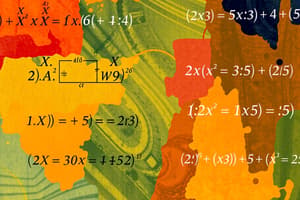Podcast
Questions and Answers
Which method is suitable for quadratic equations with simple roots?
Which method is suitable for quadratic equations with simple roots?
- Completing the square
- Factoring method (correct)
- Quadratic formula
- Graphing method
When using the completing the square method, what conditions should the coefficients satisfy?
When using the completing the square method, what conditions should the coefficients satisfy?
- $b^2 - 4ac < 0$ and $a < 0$
- $b^2 - 4ac > 0$ and $a < 0$
- $b^2 - 4ac < 0$ and $a > 0$
- $b^2 - 4ac > 0$ and $a > 0$ (correct)
What are the coefficients in a quadratic equation of the form $2x^2 + 3x - 5 = 0$?
What are the coefficients in a quadratic equation of the form $2x^2 + 3x - 5 = 0$?
- $2, 3$
- $2, 3, -5$ (correct)
- $2, -3, 5$
- $2, -3, -5$
In the equation $x^2 + 7x + 12 = 0$, what are the roots obtained using the factoring method?
In the equation $x^2 + 7x + 12 = 0$, what are the roots obtained using the factoring method?
Which method should be chosen for quadratic equations with complex roots?
Which method should be chosen for quadratic equations with complex roots?
For a quadratic equation with a discriminant greater than zero, how many real solutions exist?
For a quadratic equation with a discriminant greater than zero, how many real solutions exist?
What role does the discriminant play in quadratic equations?
What role does the discriminant play in quadratic equations?
What does a discriminant less than zero indicate about a quadratic equation?
What does a discriminant less than zero indicate about a quadratic equation?
How is a quadratic equation affected when the discriminant equals zero?
How is a quadratic equation affected when the discriminant equals zero?
In quadratic equations, what is the significance of being able to distinguish between different scenarios based on factors like discriminants?
In quadratic equations, what is the significance of being able to distinguish between different scenarios based on factors like discriminants?
Flashcards are hidden until you start studying
Study Notes
Solving Quadratic Equations in Algebra
Quadratic equations are expressions of the form (ax^2 + bx + c = 0), where (a, b,) and (c) are constants. These equations hold significant importance in algebra due to their widespread applications across various fields such as physics, engineering, finance, architecture, and more. Let's dive deeper into how to solve these critical mathematical problems.
Factoring Method
If the coefficients ((a, b,) and (c)) happen to satisfy certain conditions, we can factorize them using special products like binomials or differences of squares. For instance, consider the equation (x^2 - 5x + 6 = 0):
[ \begin{align*} & x^2 - 5x + 6 = (x - 2)(x - 3)\ &\Rightarrow \quad x=2\text{ or }x=3 \end{align*} ]
However, this method is limited since it only applies to specific types of quadratics with simple roots.
Completing the Square
Completing the square involves rearranging terms so they represent the difference of two perfect squares. This technique works well if both discriminant ((b^2 - 4ac)) and coefficient (a) are positive. Here's an example:
[ \begin{align*} & x^2 + 7x + 8 = 0 \ &= (x+7 / 2)^2 - (7/2)^2 + 8\ &= (x + 7 / 2)^2 - 29/4\ &\Rightarrow \quad x = -\frac{7}{2} \pm \sqrt{\frac{29}{4}}-\frac{7}{2}\ &= -\frac{7}{2}\pm \frac{\sqrt{29}}{2} \end{align*} ]
Discriminant Analysis & Classification of Roots
The discriminant ((D = b^2 - 4ac)) plays a vital role in determining whether there will be real solutions (roots) and how many of those solutions exist. If (D > 0):
- Two distinct real solutions (positive or negative)
If (D < 0):
- No real solutions (complex conjugate pair)
If (D = 0):
- One repeated root (double solution)
These cases help us classify the nature of the roots based solely upon the value of the discriminant.
In summary, solving quadratic equations in algebra forms a fundamental part of our understanding of mathematics and its application in diverse disciplines. While learning techniques like factoring and completing the square greatly enhance problem-solving skills, the power lies in being able to distinguish between different scenarios based on factors such as discriminants.
Studying That Suits You
Use AI to generate personalized quizzes and flashcards to suit your learning preferences.




